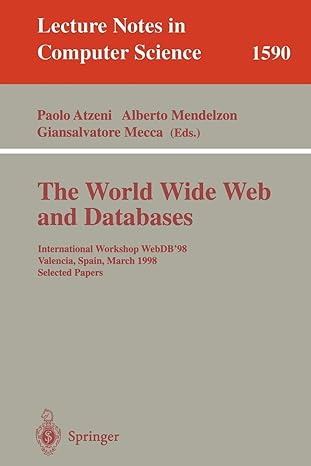cshell scripting in Linux-C language
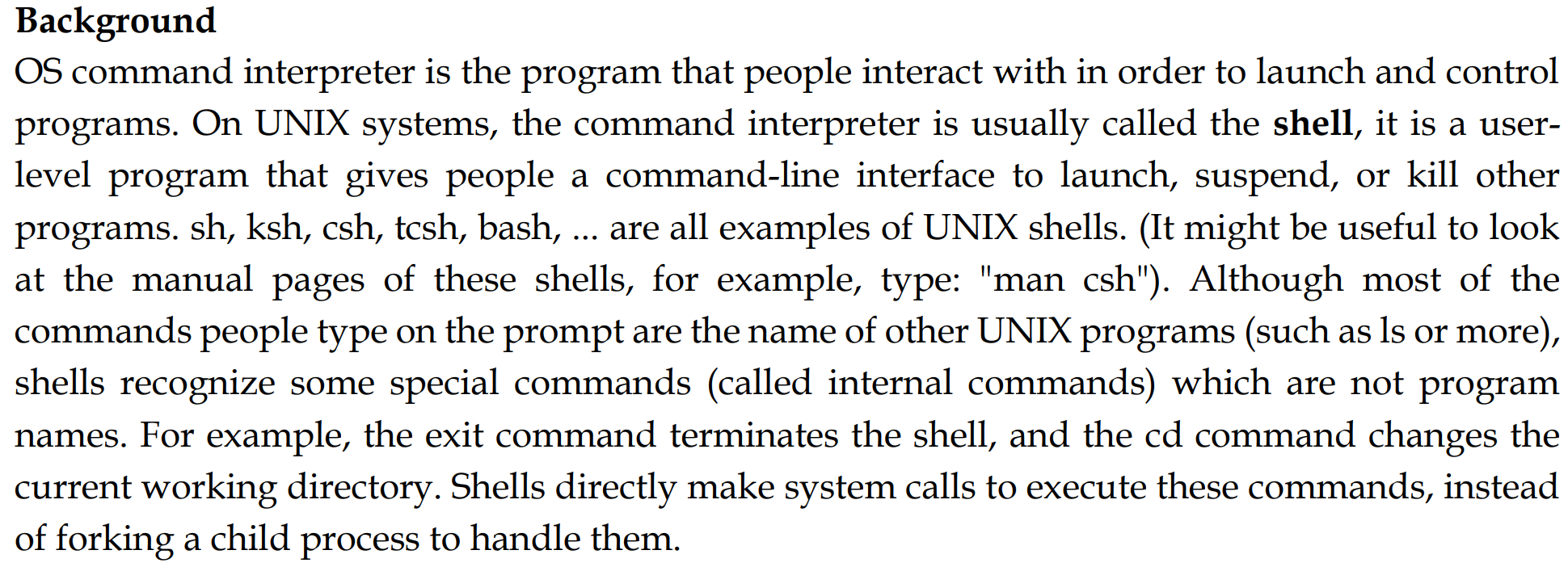
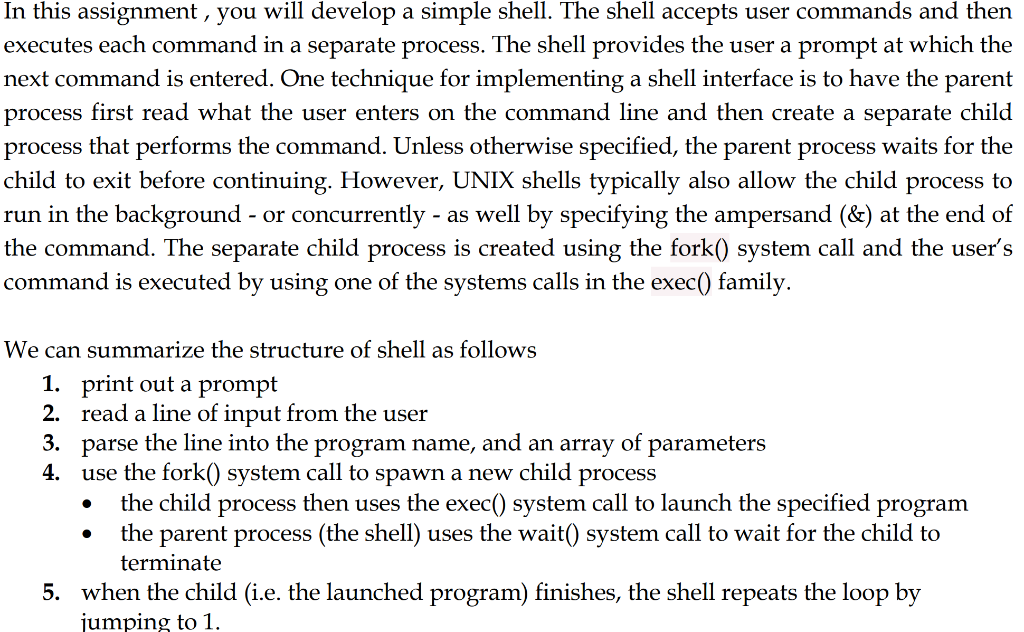
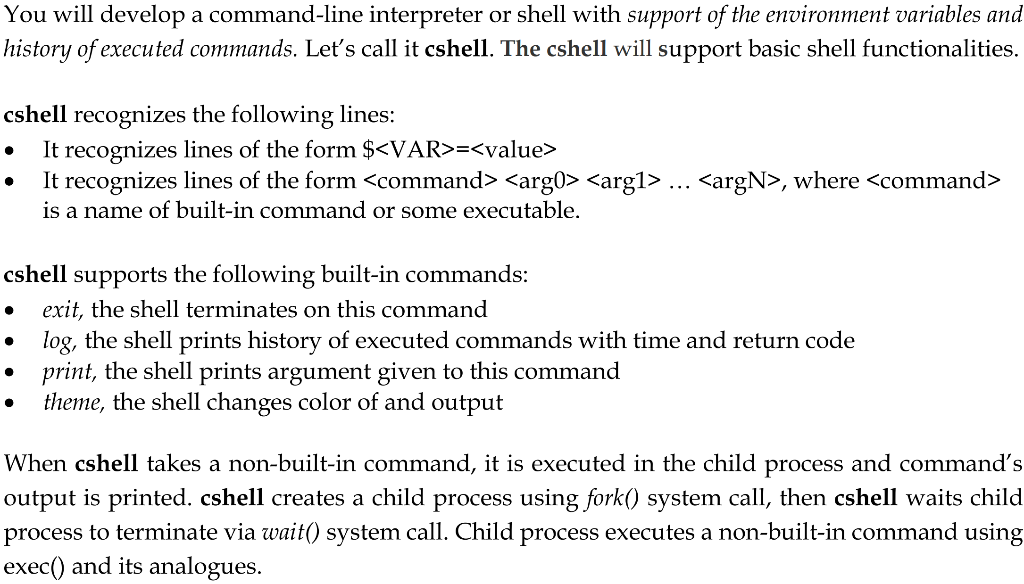
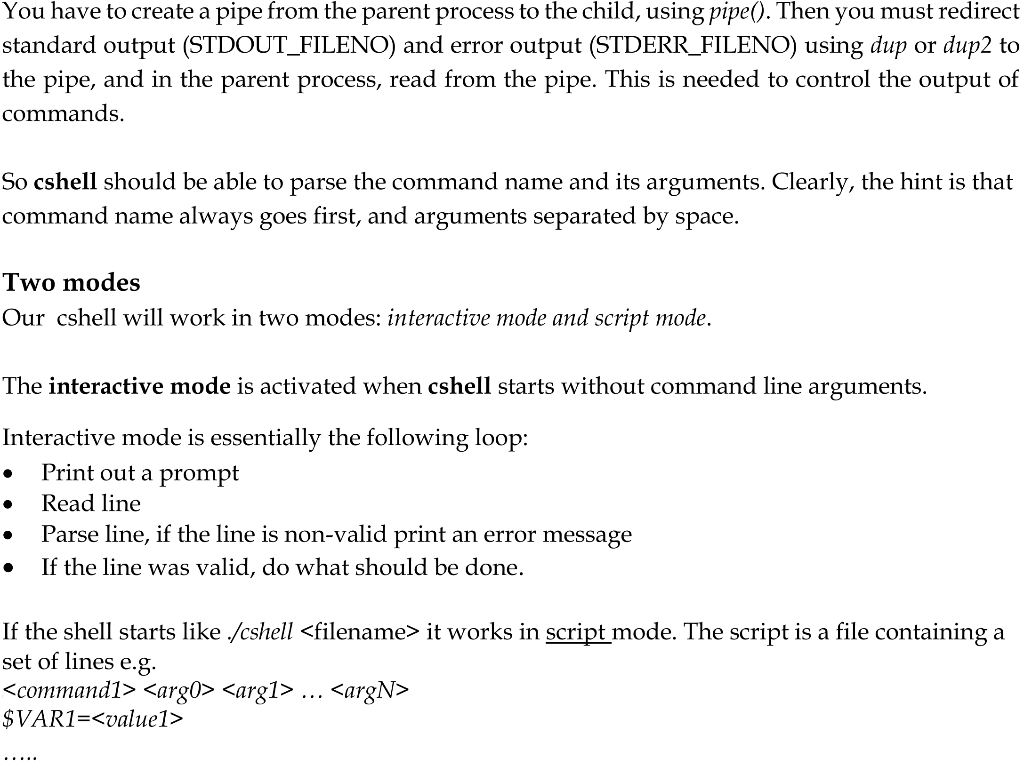
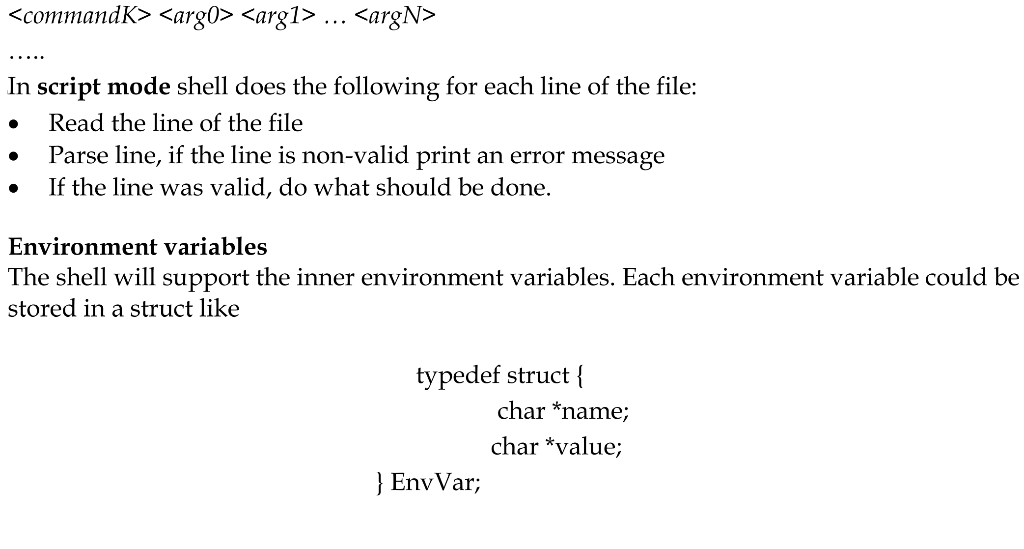
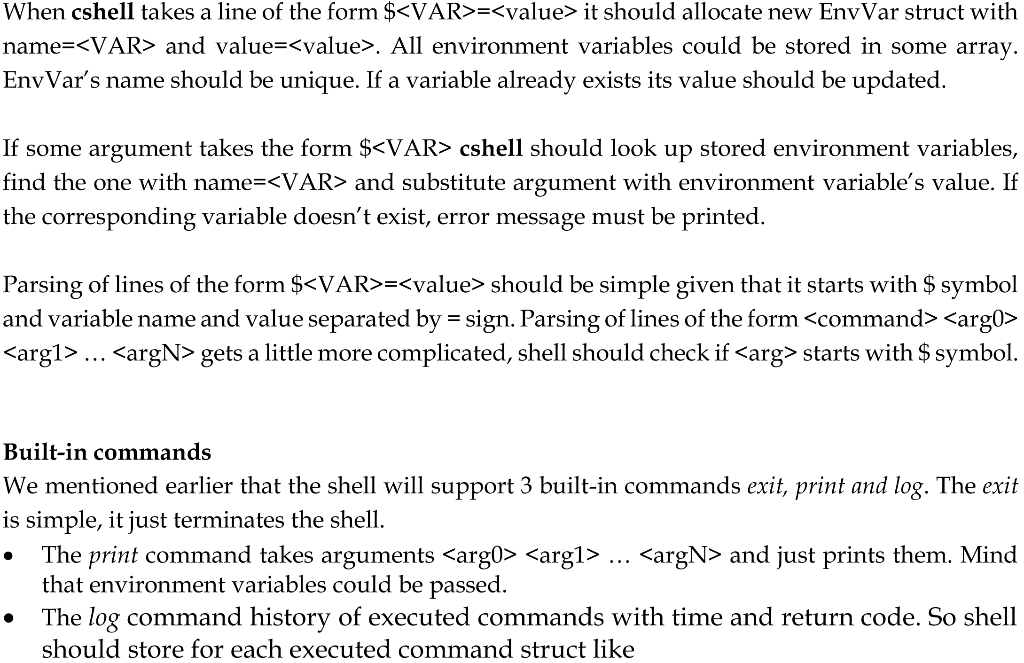
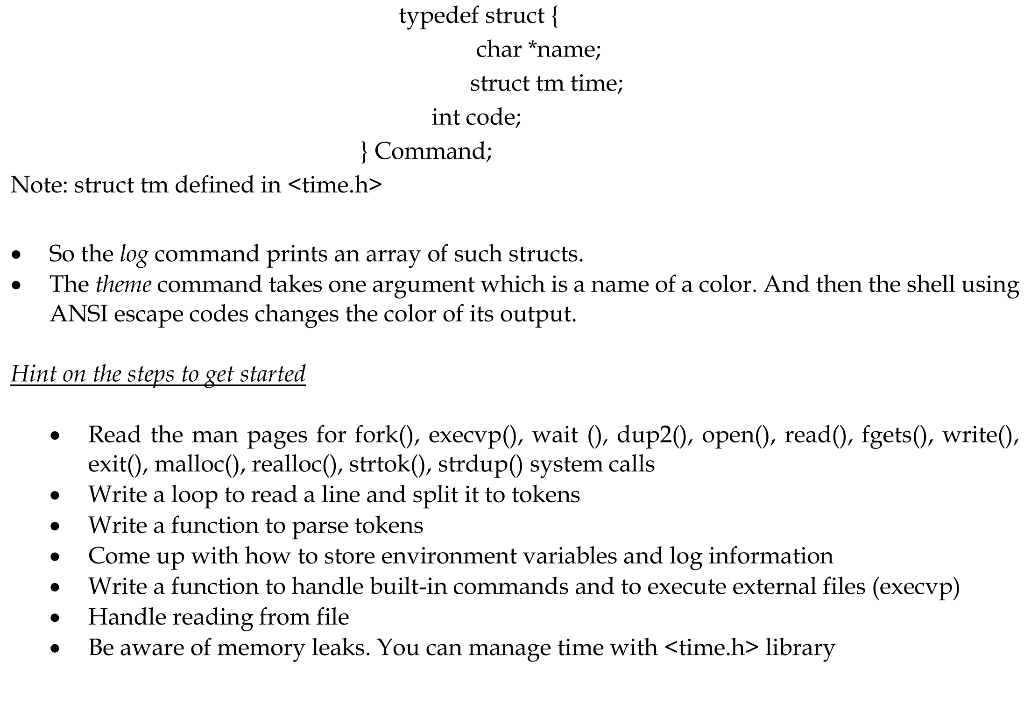
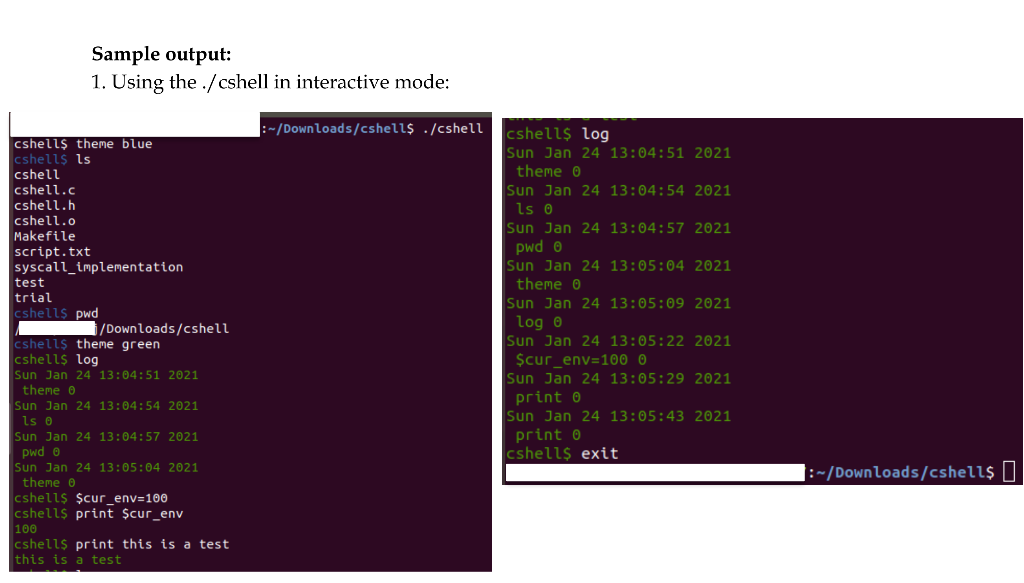
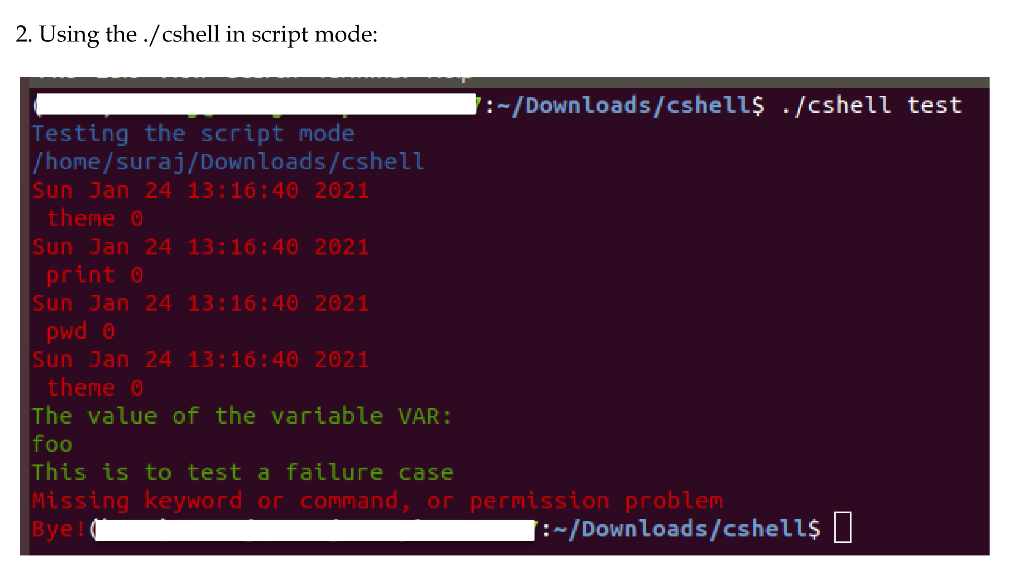
Background OS command interpreter is the program that people interact with in order to launch and control programs. On UNIX systems, the command interpreter is usually called the shell, it is a user- level program that gives people a command-line interface to launch, suspend, or kill other programs. sh, ksh, csh, tosh, bash, ... are all examples of UNIX shells. (It might be useful to look at the manual pages of these shells, for example, type: "man csh"). Although most of the commands people type on the prompt are the name of other UNIX programs (such as ls or more), shells recognize some special commands (called internal commands) which are not program names. For example, the exit command terminates the shell, and the cd command changes the current working directory. Shells directly make system calls to execute these commands, instead of forking a child process to handle them. In this assignment, you will develop a simple shell. The shell accepts user commands and then executes each command in a separate process. The shell provides the user a prompt at which the next command is entered. One technique for implementing a shell interface is to have the parent process first read what the user enters on the command line and then create a separate child process that performs the command. Unless otherwise specified, the parent process waits for the child to exit before continuing. However, UNIX shells typically also allow the child process to run in the background - or concurrently - as well by specifying the ampersand (&) at the end of the command. The separate child process is created using the fork() system call and the user's command is executed by using one of the systems calls in the exec() family. and an array We can summarize the structure of shell as follows 1. print out a prompt 2. read a line of input from the user 3. parse the line into the program name, of parameters 4. use the fork() system call to spawn a new child process the child process then uses the exec() system call to launch the specified program the parent process (the shell) uses the wait() system call to wait for the child to terminate 5. when the child (i.e. the launched program) finishes, the shell repeats the loop by jumping to 1. You will develop a command-line interpreter or shell with support of the environment variables and history of executed commands. Let's call it cshell. The cshell will support basic shell functionalities. cshell recognizes the following lines: It recognizes lines of the form $
= It recognizes lines of the form ... , where is a name of built-in command or some executable. cshell supports the following built-in commands: exit, the shell terminates on this command log, the shell prints history of executed commands with time and return code print, the shell prints argument given to this command theme, the shell changes color of and output Whe hell takes a puilt-in command, it is executed in child process and con and's output is printed. cshell creates a child process using fork() system call, then cshell waits child process to terminate via wait() system call. Child process executes a non-built-in command using exec() and its analogues. You have to create a pipe from the parent process to the child, using pipe(). Then you must redirect standard output (STDOUT_FILENO) and error output (STDERR_FILENO) using dup or dup2 to the pipe, and in the parent process, read from the pipe. This is needed to control the output of commands. So cshell should be able to parse the command name and its arguments. Clearly, the hint is that command name always goes first, and arguments separated by space. Two modes Our cshell will work in two modes: interactive mode and script mode. The interactive mode is activated when cshell starts without command line arguments. Interactive mode is essentially the following loop: Print out a prompt Read line Parse line, if the line is non-valid print an error message If the line was valid, do what should be done. If the shell starts like ./cshell it works in script mode. The script is a file containing a set of lines e.g. $VAR1= ... . In script mode shell does the following for each line of the file: Read the line of the file Parse line, if the line is non-valid print an error message If the line was valid, do what should be done. O . Environment variables The shell will support the inner environment variables. Each environment variable could be stored in a struct like typedef struct { char *name; char *value; } EnvVar; When cshell takes a line of the form $= it should allocate new Env Var struct with name= and value=. All environment variables could be stored in some array. EnvVar's name should be unique. If a variable already exists its value should be updated. If some argument takes the form $ cshell should look up stored environment variables, find the one with name= and substitute argument with environment variable's value. If the corresponding variable doesn't exist, error message must be printed. Parsing of lines of the form $= should be simple given that it starts with $ symbol and variable name and value separated by = sign. Parsing of lines of the form ... gets a little more complicated, shell should check if starts with $ symbol. Built-in commands We mentioned earlier that the shell will support 3 built-in commands exit, print and log. The exit is simple, it just terminates the shell. The print command takes arguments ... and just prints them. Mind that environment variables could be passed. The log command history of executed commands with time and return code. So shell should store for each executed command struct like typedef struct { char *name; struct tm time; int code; } Command; Note: struct tm defined in . So the log command prints an array of such structs. The theme command takes one argument which is a name of a color. And then the shell using ANSI escape codes changes the color of its output. Hint on the steps to get started Read the man pages for fork(), execvp(), wait (), dup2(), open(), read(), fgets(), write(), exit(), malloc(), realloc(), strtok(), strdup() system calls Write a loop to read a line and split it to tokens Write a function to parse tokens Come up with how to store environment variables and log information Write a function to handle built-in commands and to execute external files (execvp) Handle reading from file Be aware of memory leaks. You can manage time with library . . Sample output: 1. Using the ./cshell in interactive mode: :-/Downloads/cshell$ ./cshell cshells theme blue cshells ls cshell cshell.c cshell.h cshell.o Makefile script.txt syscall_implementation test trial cshells pwd Downloads/cshell cshells theme green cshells log Sun Jan 24 13:04:51 2021 theme 0 Sun Jan 24 13:04:54 2021 Is 0 Sun Jan 24 13:04:57 2021 pwd 0 Sun Jan 24 13:05:04 2021 theme o cshells $cur_env=100 cshells print $cur_env 100 cshells print this is a test this is a test cshells log Sun Jan 24 13:04:51 2021 theme 0 Sun Jan 24 13:04:54 2021 Is 0 Sun Jan 24 13:04:57 2021 pwd o Sun Jan 24 13:05:04 2021 theme 0 Sun Jan 24 13:05:09 2021 logo Sun Jan 24 13:05:22 2021 $cur_env=1000 Sun Jan 24 13:05:29 2021 print 0 Sun Jan 24 13:05:43 2021 print 0 cshells exit 1:~/Downloads/cshells | 2. Using the ./cshell in script mode: :-/Downloads/cshells ./cshell test Testing the script mode /home/suraj/Downloads/cshell Sun Jan 24 13:16:40 2021 theme 0 Sun Jan 24 13:16:40 2021 print 0 Sun Jan 24 13:16:40 2021 pwd @ Sun Jan 24 13:16:40 2021 theme 0 The value of the variable VAR: foo This is to test a failure case Missing keyword or command, or permission problem Bye! 1:-/Downloads/cshells | Background OS command interpreter is the program that people interact with in order to launch and control programs. On UNIX systems, the command interpreter is usually called the shell, it is a user- level program that gives people a command-line interface to launch, suspend, or kill other programs. sh, ksh, csh, tosh, bash, ... are all examples of UNIX shells. (It might be useful to look at the manual pages of these shells, for example, type: "man csh"). Although most of the commands people type on the prompt are the name of other UNIX programs (such as ls or more), shells recognize some special commands (called internal commands) which are not program names. For example, the exit command terminates the shell, and the cd command changes the current working directory. Shells directly make system calls to execute these commands, instead of forking a child process to handle them. In this assignment, you will develop a simple shell. The shell accepts user commands and then executes each command in a separate process. The shell provides the user a prompt at which the next command is entered. One technique for implementing a shell interface is to have the parent process first read what the user enters on the command line and then create a separate child process that performs the command. Unless otherwise specified, the parent process waits for the child to exit before continuing. However, UNIX shells typically also allow the child process to run in the background - or concurrently - as well by specifying the ampersand (&) at the end of the command. The separate child process is created using the fork() system call and the user's command is executed by using one of the systems calls in the exec() family. and an array We can summarize the structure of shell as follows 1. print out a prompt 2. read a line of input from the user 3. parse the line into the program name, of parameters 4. use the fork() system call to spawn a new child process the child process then uses the exec() system call to launch the specified program the parent process (the shell) uses the wait() system call to wait for the child to terminate 5. when the child (i.e. the launched program) finishes, the shell repeats the loop by jumping to 1. You will develop a command-line interpreter or shell with support of the environment variables and history of executed commands. Let's call it cshell. The cshell will support basic shell functionalities. cshell recognizes the following lines: It recognizes lines of the form $= It recognizes lines of the form ... , where is a name of built-in command or some executable. cshell supports the following built-in commands: exit, the shell terminates on this command log, the shell prints history of executed commands with time and return code print, the shell prints argument given to this command theme, the shell changes color of and output Whe hell takes a puilt-in command, it is executed in child process and con and's output is printed. cshell creates a child process using fork() system call, then cshell waits child process to terminate via wait() system call. Child process executes a non-built-in command using exec() and its analogues. You have to create a pipe from the parent process to the child, using pipe(). Then you must redirect standard output (STDOUT_FILENO) and error output (STDERR_FILENO) using dup or dup2 to the pipe, and in the parent process, read from the pipe. This is needed to control the output of commands. So cshell should be able to parse the command name and its arguments. Clearly, the hint is that command name always goes first, and arguments separated by space. Two modes Our cshell will work in two modes: interactive mode and script mode. The interactive mode is activated when cshell starts without command line arguments. Interactive mode is essentially the following loop: Print out a prompt Read line Parse line, if the line is non-valid print an error message If the line was valid, do what should be done. If the shell starts like ./cshell it works in script mode. The script is a file containing a set of lines e.g. $VAR1= ... . In script mode shell does the following for each line of the file: Read the line of the file Parse line, if the line is non-valid print an error message If the line was valid, do what should be done. O . Environment variables The shell will support the inner environment variables. Each environment variable could be stored in a struct like typedef struct { char *name; char *value; } EnvVar; When cshell takes a line of the form $= it should allocate new Env Var struct with name= and value=. All environment variables could be stored in some array. EnvVar's name should be unique. If a variable already exists its value should be updated. If some argument takes the form $ cshell should look up stored environment variables, find the one with name= and substitute argument with environment variable's value. If the corresponding variable doesn't exist, error message must be printed. Parsing of lines of the form $= should be simple given that it starts with $ symbol and variable name and value separated by = sign. Parsing of lines of the form ... gets a little more complicated, shell should check if starts with $ symbol. Built-in commands We mentioned earlier that the shell will support 3 built-in commands exit, print and log. The exit is simple, it just terminates the shell. The print command takes arguments ... and just prints them. Mind that environment variables could be passed. The log command history of executed commands with time and return code. So shell should store for each executed command struct like typedef struct { char *name; struct tm time; int code; } Command; Note: struct tm defined in . So the log command prints an array of such structs. The theme command takes one argument which is a name of a color. And then the shell using ANSI escape codes changes the color of its output. Hint on the steps to get started Read the man pages for fork(), execvp(), wait (), dup2(), open(), read(), fgets(), write(), exit(), malloc(), realloc(), strtok(), strdup() system calls Write a loop to read a line and split it to tokens Write a function to parse tokens Come up with how to store environment variables and log information Write a function to handle built-in commands and to execute external files (execvp) Handle reading from file Be aware of memory leaks. You can manage time with library . . Sample output: 1. Using the ./cshell in interactive mode: :-/Downloads/cshell$ ./cshell cshells theme blue cshells ls cshell cshell.c cshell.h cshell.o Makefile script.txt syscall_implementation test trial cshells pwd Downloads/cshell cshells theme green cshells log Sun Jan 24 13:04:51 2021 theme 0 Sun Jan 24 13:04:54 2021 Is 0 Sun Jan 24 13:04:57 2021 pwd 0 Sun Jan 24 13:05:04 2021 theme o cshells $cur_env=100 cshells print $cur_env 100 cshells print this is a test this is a test cshells log Sun Jan 24 13:04:51 2021 theme 0 Sun Jan 24 13:04:54 2021 Is 0 Sun Jan 24 13:04:57 2021 pwd o Sun Jan 24 13:05:04 2021 theme 0 Sun Jan 24 13:05:09 2021 logo Sun Jan 24 13:05:22 2021 $cur_env=1000 Sun Jan 24 13:05:29 2021 print 0 Sun Jan 24 13:05:43 2021 print 0 cshells exit 1:~/Downloads/cshells | 2. Using the ./cshell in script mode: :-/Downloads/cshells ./cshell test Testing the script mode /home/suraj/Downloads/cshell Sun Jan 24 13:16:40 2021 theme 0 Sun Jan 24 13:16:40 2021 print 0 Sun Jan 24 13:16:40 2021 pwd @ Sun Jan 24 13:16:40 2021 theme 0 The value of the variable VAR: foo This is to test a failure case Missing keyword or command, or permission problem Bye! 1:-/Downloads/cshells |















